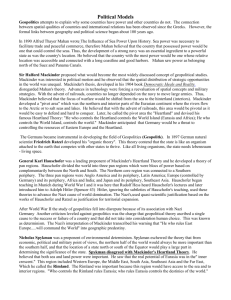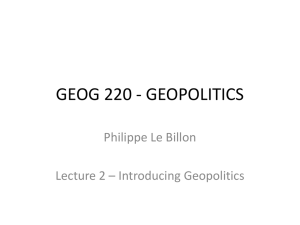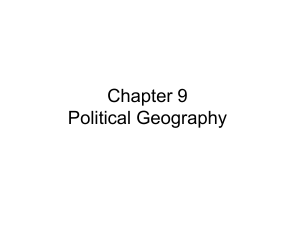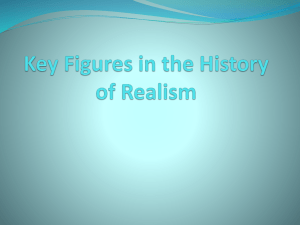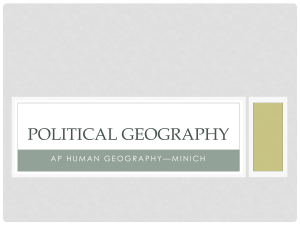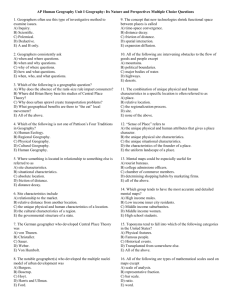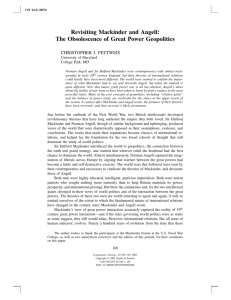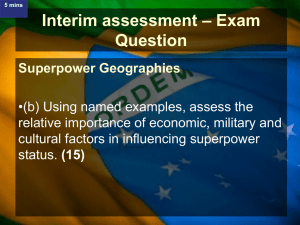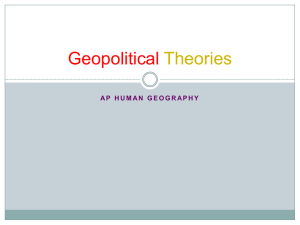View/Open
advertisement
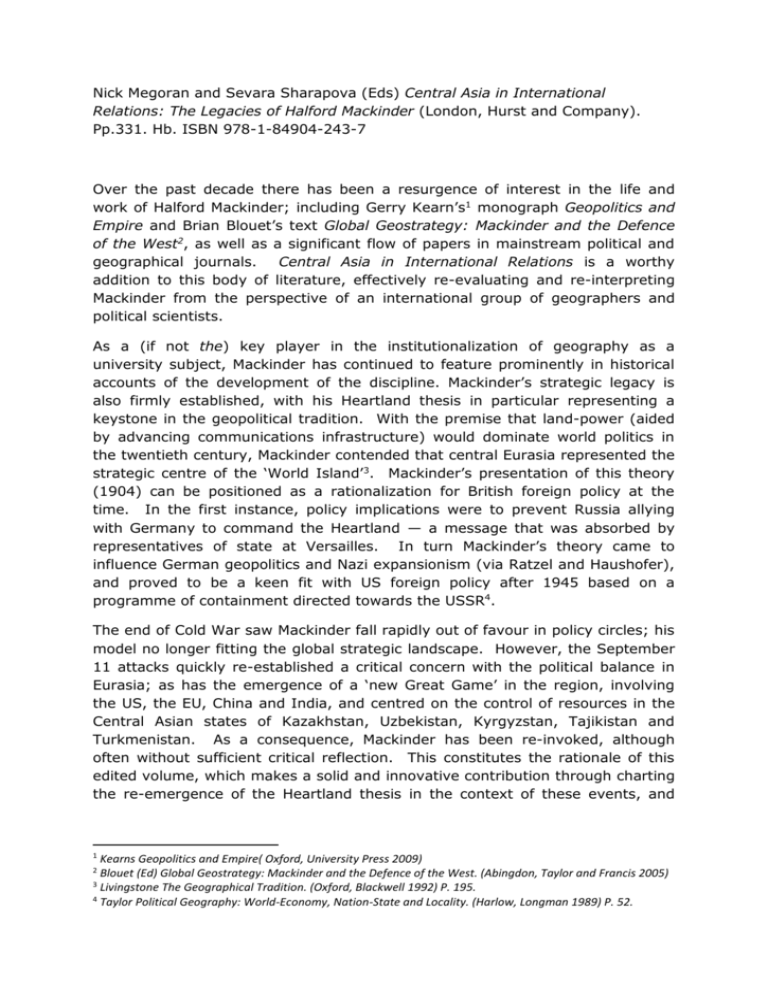
Nick Megoran and Sevara Sharapova (Eds) Central Asia in International Relations: The Legacies of Halford Mackinder (London, Hurst and Company). Pp.331. Hb. ISBN 978-1-84904-243-7 Over the past decade there has been a resurgence of interest in the life and work of Halford Mackinder; including Gerry Kearn’s1 monograph Geopolitics and Empire and Brian Blouet’s text Global Geostrategy: Mackinder and the Defence of the West2, as well as a significant flow of papers in mainstream political and geographical journals. Central Asia in International Relations is a worthy addition to this body of literature, effectively re-evaluating and re-interpreting Mackinder from the perspective of an international group of geographers and political scientists. As a (if not the) key player in the institutionalization of geography as a university subject, Mackinder has continued to feature prominently in historical accounts of the development of the discipline. Mackinder’s strategic legacy is also firmly established, with his Heartland thesis in particular representing a keystone in the geopolitical tradition. With the premise that land-power (aided by advancing communications infrastructure) would dominate world politics in the twentieth century, Mackinder contended that central Eurasia represented the strategic centre of the ‘World Island’3. Mackinder’s presentation of this theory (1904) can be positioned as a rationalization for British foreign policy at the time. In the first instance, policy implications were to prevent Russia allying with Germany to command the Heartland — a message that was absorbed by representatives of state at Versailles. In turn Mackinder’s theory came to influence German geopolitics and Nazi expansionism (via Ratzel and Haushofer), and proved to be a keen fit with US foreign policy after 1945 based on a programme of containment directed towards the USSR4. The end of Cold War saw Mackinder fall rapidly out of favour in policy circles; his model no longer fitting the global strategic landscape. However, the September 11 attacks quickly re-established a critical concern with the political balance in Eurasia; as has the emergence of a ‘new Great Game’ in the region, involving the US, the EU, China and India, and centred on the control of resources in the Central Asian states of Kazakhstan, Uzbekistan, Kyrgyzstan, Tajikistan and Turkmenistan. As a consequence, Mackinder has been re-invoked, although often without sufficient critical reflection. This constitutes the rationale of this edited volume, which makes a solid and innovative contribution through charting the re-emergence of the Heartland thesis in the context of these events, and 1 Kearns Geopolitics and Empire( Oxford, University Press 2009) Blouet (Ed) Global Geostrategy: Mackinder and the Defence of the West. (Abingdon, Taylor and Francis 2005) 3 Livingstone The Geographical Tradition. (Oxford, Blackwell 1992) P. 195. 4 Taylor Political Geography: World-Economy, Nation-State and Locality. (Harlow, Longman 1989) P. 52. 2 asking whether or not Mackinder’s ideas continue to be of value in understanding the international politics of Central Asia today (if, indeed, they ever have been). In addressing this question, the book explicitly identifies and sets out to address a trio of specified shortcomings in the literature on Mackinder. Firstly Megoran and Sharapova take issue with a propensity among some Central Asianists to glibly use Mackinder as justificatory shorthand for the enduring importance of the region on the worldwide stage. As such, there is tendency to gloss over the evolution of, and contradictions, within Mackinder’s arguments, including, for example, his position on notions of environmental determinism and the role of technological advancement. This leads on to a second criticism, which is the inclination of many scholars to simplistically characterize Mackinder as an apologist for imperialism. Such a generalization, it is maintained, does not hold water and serves as a crass, underdeveloped depiction of both the man and the environment he operated within. Thirdly, Megoran, Sharapova and colleagues call attention to a substantial gap in our understanding of how Mackinder’s ideas—akin to geopolitical ideas more generally— have ‘travelled’ between different sites. As a basis for exploring these issues the book is structured into three sections, the first of which focuses on the complex relationship between Mackinder and imperialism. This point is particularly well made in the chapters provided by Blouet and Kearns, which trace out Mackinder’s early career as a journalist and academic, his directorship of the LSE, his short-lived political career and his role as British High Commissioner in Southern Russia. Demonstrating the evolution of Mackinder’s ideas through these shifting circumstances, the picture painted of the man is not one of an ‘unapologetic, right wing imperialist zealot’ as has often been the case in past biographies (p. 50). Instead, Mackinder is portrayed as an individual whose marked preference for democratic ideals and self-determination among small nations was tempered by a realist perspective on global power politics and the requirement to protect British subjects (and assets) from the threat of Bolshevism. This pragmatic stance translates into inconsistency in Mackinder’s writing, making it somewhat difficult to pigeon-hole his world-view, or easily distil his collective output. The second part considers the influence of Mackinder’s discourse on scholars and policy makers at work in Central Asia in the post-USSR era. This arguably represents the most innovative aspect of the book insofar as it is undertaken from the standpoint of actors within the ‘Heartland’ - as opposed to the positions adopted by those external forces looking to influence this space. With geopolitics being condemned by the Soviet Union on ideological grounds, the popularity of Mackinders work in the Central Asian republics increased steadily from the late 1980s onwards to the point where, states Nourzhanov, it ‘has become the paradigm of choice in theorising international relations’ (p. 170). This circumstance, it is collectively argued, is both understandable and problematic. Exciting precisely because it was forbidden, Sharapova reasons that the Heartland thesis quickly became especially important for satellite states ‘lacking experience of acting in the international arena [and] thirsty for theoretical material that could make sense of the place of the region in world affairs’ (p. 173). This analysis resonates with those provided by Nourzhanov and Hauner; both of whom highlight the often patchy and superficial engagement with Mackinder among a newer breed of Asian policy-makers. For Hauner in particular, the tendency for Mackinder’s theories to find favour with shifting geopolitical circumstances and historical events is testament to its ambiguity as much as its foresight and this is echoed in the third section of the volume. With contributions from Deiple, Dundich, Dadabayeva and Adibayeva, and Heikimoglu, all of whom advocate caution in unproblematically transposing Mackinder’s ideas onto contemporary Eurasian geopolitics, the most scathing critique of this practise comes from the latter. In specific, Hekimoglu takes issue not only with the act of stretching Mackinder’s ideas too far out of their original context, but also with the central tenets of the original model. Chiefly, they dispute Mackinder’s assessment of the agricultural potential of Russian Asia and the propensity for current commentaries to exaggerate the comparative level of oil and mineral reserves in the region. In conclusion, Hekimoglu notes that it is with ‘sadness’ that people continue ‘to listen to those who are engaged in building a mirage based on 2 prevalent dogmas: the Mackinderian one that Central Asia has vast resources of great global significance, and the neo-liberal one that economic liberalisation is a panacea to the problems of development irrespective of geography’ (p. 288). Bringing the debate full-circle, this contentious assertion brings balance to a text which explores the influence and relevance of Mackinder to contemporary geopolitical discourse, and one which provides a distinctly nuanced depiction of the man and his influences. Perhaps the biggest shortcoming of the book is the level of repetition between the chapters. This is most noticeable in respect to biographical information and details of British foreign policy, but this is, perhaps, to be expected of an edited volume focusing on a relatively specific subject matter. In sum, this is an essential text academics concerned with the relevance of Mackinder today, and will also find an audience with a broader readership interested in the emergence of the ‘New Great Game’ in Central Asia. JESSE HELEY Aberystwyth University Email: eyh@aber.ac.uk

